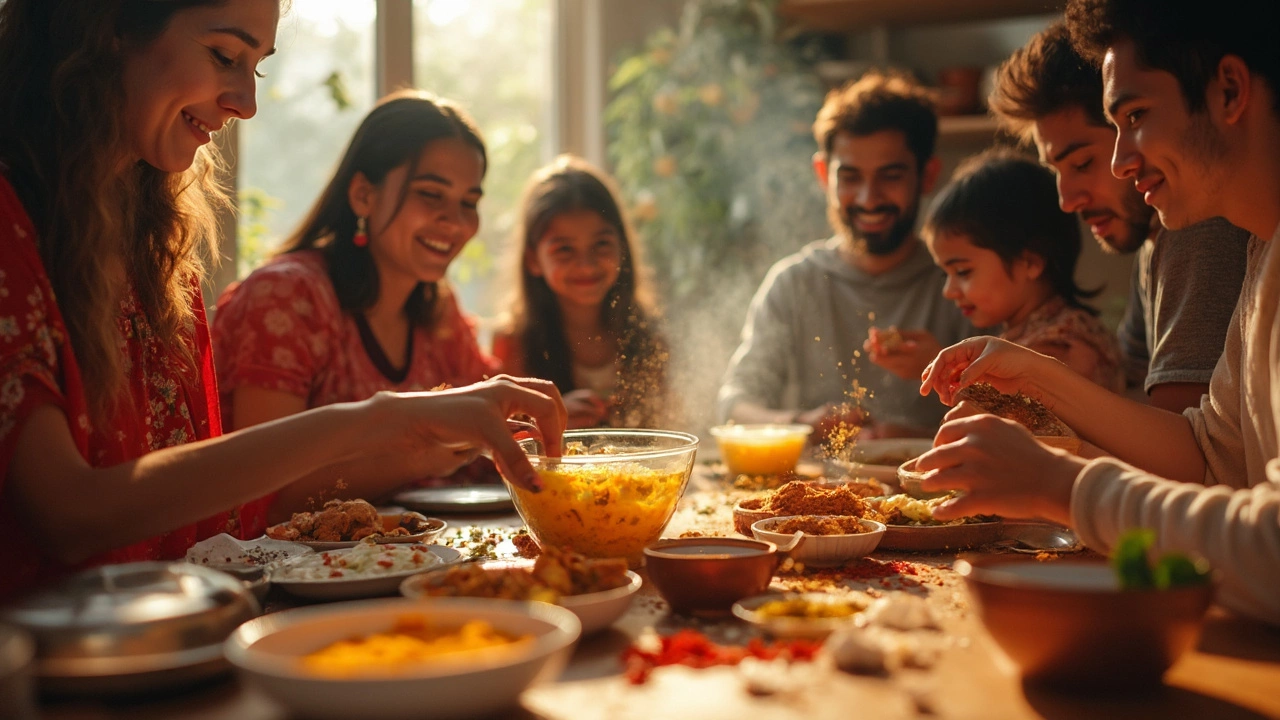If you want chicken that’s juicy, bold, and tastes like it came straight out of a proper tandoor, the secret isn’t in a long list of pricey spices—it's all about a balanced marinade. You don’t need a million ingredients. When you know the basic formula, you can easily whip up tandoori-style chicken with stuff you probably have at home.
The trick is four things: something tangy, something creamy, salt, and a simple mix of spices. If you can remember that, you’re way ahead of the game. Most classic tandoori chicken recipes use yogurt as the base. It tenderizes the chicken and lets all the flavors soak in. Throw in lemon juice or vinegar for that signature tang. The rest? Good salt and a few key ground spices make all the difference.
No need to panic over not owning a spice grinder or finding obscure powders—regular chili powder, turmeric, cumin, and garam masala are solid choices. Don’t skip the salt; it’s not just about flavor, but also helps the chicken stay juicy after cooking. And that’s honestly the foundation of every tandoori marinade, whether you’re grilling, roasting, or even air frying your chicken. Start with this base, and soon you’ll be tweaking it to suit your own tastes.
- The 4 Essential Elements of Tandoori Marinade
- Understanding the Role of Each Ingredient
- Easy Ratios and Real-World Examples
- Smart Tips for Customizing Your Marinade
The 4 Essential Elements of Tandoori Marinade
If you strip away all the extras, every tandoori marinade has four big players: dairy (usually yogurt), an acid, spices, and salt. When you get this mix right, you get that signature flavor and juicy texture we all want.
- Yogurt (the creamy base): This isn’t just for taste. Yogurt’s lactic acid helps break down tough chicken fibers, making the meat tender. And it holds onto the spices, so nothing falls off. Indian plain dahi (curd) is traditional, but Greek yogurt works too if you prefer a thicker marinade.
- Acid (think lemon juice or vinegar): This sharpens the flavor and boosts the tenderizing power. Lemon juice is classic for tandoori chicken, but white vinegar is another go-to, especially in restaurant kitchens.
- Spices (the flavor boost): Here’s where things get fun. You want spices that pack a punch but are easy to find. For most, a simple combo of red chili powder, cumin, turmeric, and garam masala will do the trick. Kashmiri chili powder gives more color and less burn, which is why so many Indian cooks use it.
- Salt (not just for flavor): Salt is more than a flavor booster—it helps the meat hold onto moisture, so you don’t end up with dry chicken. Never skip it or skimp on it if you want results like the pros.
Here’s a simple data table to show you the effect of each ingredient on basic marinade formula for chicken:
| Element | Common Choices | Role in Marinade |
|---|---|---|
| Dairy | Yogurt (plain, Greek) | Tenderizes, coats chicken, helps spices stick |
| Acid | Lemon juice, vinegar | Brightens flavor, breaks down protein |
| Spices | Chili powder, cumin, turmeric, garam masala | Adds color, aroma, and taste |
| Salt | Table salt, sea salt | Locks in moisture, balances flavors |
For quick reference, just remember: creamy base, tang, bold spices, and the right amount of salt. Once these are balanced, you’ve nailed the backbone of every great tandoori chicken marinade.
Understanding the Role of Each Ingredient
Getting the marinade right for tandoori chicken is all about understanding what each ingredient brings to the table. It's not just mixing everything together—each part actually changes the way your chicken tastes and feels.
Here’s what you need to know:
- Yogurt: This is the main player in your marinade. Plain, thick yogurt is perfect because the natural acidity breaks down the chicken’s proteins, making the meat extra tender and juicy. Greek yogurt is especially popular for its creaminess, but regular plain yogurt works great too.
- Tangy Agent (Lemon juice or Vinegar): Tang is what sets tandoori chicken apart. Lemon juice or white vinegar increases the acidity, helping the marinade go deeper into the chicken and giving it that punchy flavor. Around 1-2 tablespoons per cup of yogurt is usually enough.
- Salt: Don’t underestimate salt. It’s not just there for taste. Salt helps the chicken absorb the marinade (a simple brining effect), making the inside as tasty as the outside. Kosher or sea salt dissolves best.
- Spices: Here’s where you get all those classic colors and flavors. Usually, you’ll use ground chili (for heat and color), turmeric (for earthy notes and that signature golden color), cumin, coriander, and garam masala. The exact mix is flexible, but these cover most bases. Each spice has its own purpose: chili powder adds a kick, garam masala gives warmth, and turmeric provides earthiness.
If you like it spicy, throw in some extra chili powder or even a little cayenne. Want that smoky restaurant flavor? A pinch of smoked paprika can do wonders, or go old-school and char your chicken over a flame.
| Ingredient | Main Role | Common Amount (per 500g chicken) |
|---|---|---|
| Yogurt | Tenderizes, binds flavors | 1 cup |
| Lemon juice/Vinegar | Adds tang, helps penetration | 2 tbsp |
| Salt | Enhances & seasons, keeps moist | 1 tsp |
| Spices | Adds flavor & color | 2–3 tbsp total mix |
Keeping these roles in mind will help you tweak your basic marinade formula for chicken and make it your own. Don’t be afraid to experiment, because tiny changes can make a huge flavor difference. Your next basic marinade formula could be the best on the block.

Easy Ratios and Real-World Examples
When you’re staring at raw chicken and wondering how much of everything to toss in for that basic marinade formula, a simple ratio can be your best friend. Most Indian home cooks keep it straightforward and eyeball with confidence, but here’s a real-world ratio that actually works, especially if you’re not winging it:
- 1 cup plain yogurt
- 2 tablespoons lemon juice (or vinegar)
- 1 tablespoon ginger-garlic paste (or 2 teaspoons each, grated fresh)
- 1 to 1.5 teaspoons salt
- 2 teaspoons ground coriander
- 1 teaspoon chili powder (regular or Kashmiri for color and less heat)
- 1 teaspoon ground cumin
- 0.5 teaspoon turmeric
- 1 teaspoon garam masala
This amount will cover about 1 kilogram (just over 2 lbs) of chicken, whether it’s bone-in pieces or boneless chunks. Want it more fiery? Double up the chili powder. No yogurt? You can swap with sour cream or even thick buttermilk, but keep that creamy base for best results.
Check out how these ratios play out with different ways people use them at home and in restaurants. Here’s a quick look at some actual marinade mixes for tandoori chicken from Indian households and eateries:
| Source | Yogurt | Lemon Juice | Salt | Main Spices |
|---|---|---|---|---|
| Classic Home Cook | 1 cup | 2 tbsp | 1.5 tsp | Coriander, cumin, turmeric, garam masala |
| Restaurant Style | 2 cups | 3 tbsp | 2 tsp | Chili powder, paprika, cumin, chat masala |
| Quick Weeknight | 0.5 cup (or 3/4 cup sour cream) | 1 tbsp | 1 tsp | Chili powder, ginger powder, garlic powder |
Don’t stress about hitting the numbers perfectly. The real trick is enough marinade to coat every piece, with enough acid to break down the chicken a bit. Taste the marinade before adding the chicken—if it isn’t bursting with flavor now, it won’t be after cooking! If you want to batch-prep, double the amounts and refrigerate the leftover marinade for up to 3 days, but never reuse marinade that’s touched raw chicken.
Smart Tips for Customizing Your Marinade
Tweaking your basic marinade formula is where you can really make tandoori chicken your own—no two kitchens or taste buds are exactly the same. Personalizing the marinade is easy once you know the moves. Here’s how to get even more flavor and flexibility out of what you already have at home:
- Swap Your Tangy Base: If you're out of yogurt, try buttermilk or even thick coconut milk for a dairy-free option. Each brings its own texture and flavor, so experiment and see what you like best.
- Play With Acids: Lemon juice is classic, but lime juice or apple cider vinegar work well, too. Each acid will adjust the sharpness and brightness of the marinade. Vinegar can help if you like a more punchy flavor.
- Spices – Go Bold or Mellow: If you want more heat, add a little more chili powder or even a fresh green chili pasted up. If your family likes it milder, pull back the chili and lean into spices like cumin and coriander.
- Add Aromatics: Garlic and ginger paste are a must in authentic versions. A tablespoon of each wakes up the marinade and makes everything taste fresher.
- Color Without Chemicals: For that iconic tandoori red, skip the artificial food coloring and use Kashmiri chili powder or a pinch of paprika for color but not too much heat.
- Salt Matters: Table salt works fine, but sea salt or even black salt (kala namak) boosts umami flavors and adds complexity.
Want to see how popular choices compare? Check out these quick average marinade component percentages, based on recipes from well-known Indian home cooks and cooks who share on YouTube. It gives you an idea of how much flexibility you have to play around:
| Ingredient | Common % of total marinade |
|---|---|
| Yogurt/base | 60-70% |
| Lemon/vinegar | 10-15% |
| Spices (dry) | 10-15% |
| Salt | 3-5% |
| Garlic/Ginger | 5-7% |
One thing many people forget: marination time. For best results, let your chicken sit in the marinade for at least 4 hours—overnight is even better for deep flavor. If you’re short on time, prick the chicken with a fork so the marinade sinks in faster.
If you want to really mix things up, try tossing in a spoonful of mustard oil or ghee to give it a restaurant-style finish. Both are common in many North Indian kitchens and add a boost of savory depth.
Keep a small taste-test going whenever you marinate—dip a piece of bread in and adjust before pouring it over your chicken. Once you get the hang of the basics and these custom tweaks, you’ll never want store-bought marinades again.
